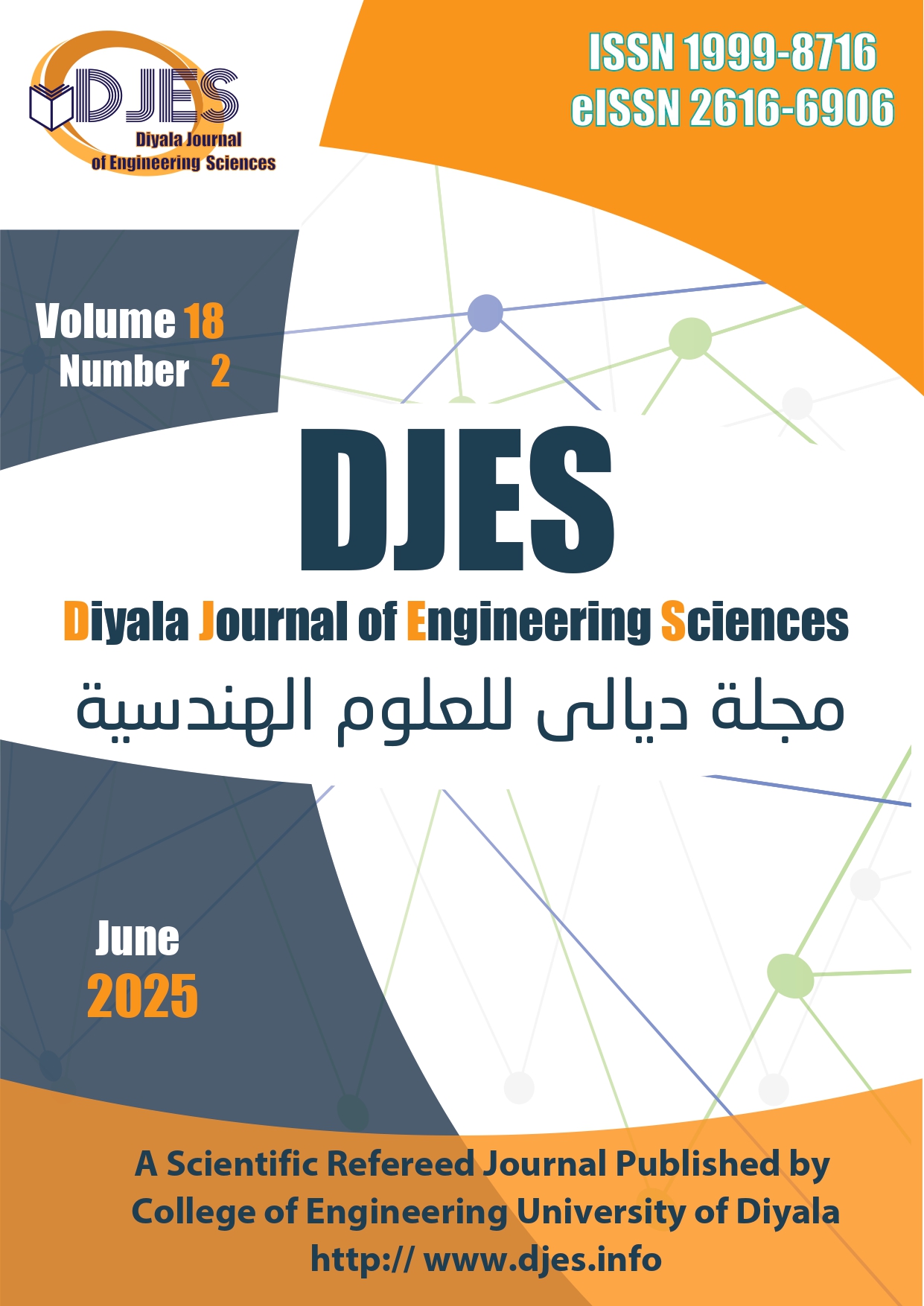Analysis the Causes delay from contractors in Construction Projects using fuzzy AHP
DOI:
https://doi.org/10.24237/djes.2024.18207Keywords:
Construction projects , Causes for delays , Contractors- Delay , Fuzzy analytic hierarchy processAbstract
Construction project delays are a recurring problem that have a big influence on stakeholder satisfaction, project budgets, and schedules. The fuzzy Analytic Hierarchy Process (AHP) is used in this study to discover, classify, and rank delay causes as it relates to contractor-induced delays. Seventy components were first discovered and categorized into six groups: finance, project management, materials, equipment, external factors, and manpower. This was done using a thorough process that included literature reviews, case studies, expert interviews, and surveys. Financial considerations have the highest weight (0.36743), followed by project management (0.23959) and material-related factors (0.1601), according to the fuzzy AHP model. The results highlight how important it is to deal with payment delays and to mitigate them through efficient project planning, material procurement, and equipment maintenance. This study offers a thorough framework for comprehending and controlling delays caused by contractors, along with useful suggestions to enhance efficiency and reduce risks.
Downloads
References
[1] S. D. Kebede and T. Zhang, “Enforcement of legal remedies against construction projects time overrun in Ethiopia: A critical appraisal,” Heliyon, vol. 6, no. 10, 2020.
[2] M. Abbasinia and I. Mohammadfam, “Identifying, evaluating and prioritizing the causes of occupational accidents in the construction industry using fuzzy AHP and fuzzy TOPSIS,” Work, vol. 72, no. 3, pp. 933–940, 2022, doi: 10.3233/WOR-210024.
[3] S. Nightingale, H. Spiby, K. Sheen, and P. Slade, “LJMU Research Online m,” Tour. Recreat. Res., p. 19, 2018, [Online]. Available: http://researchonline.ljmu.ac.uk/id/eprint/8705/
[4] L. Muhwezi, F. Tumusime Musiime, and C. Onyutha, “Assessment of the Effects of Procurement Planning Processes on Performance of Construction Contracts in Local Governments in Uganda,” J. Civil, Constr. Environ. Eng., vol. 5, no. 6, p. 151, 2020, doi: 10.11648/j.jccee.20200506.12.
[5] S. A. Assaf and S. Al-Hejji, “Causes of delay in large construction projects,” Int. J. Proj. Manag., vol. 24, no. 4, pp. 349–357, 2006, doi: 10.1016/j.ijproman.2005.11.010.
[6] Z. Ren, M. Atout, and J. Jones, “Root causes of construction project delays in Dubai,” Assoc. Res. Constr. Manag. ARCOM 2008 - Proc. 24th Annu. Conf., vol. 2, no. September, pp. 749–757, 2008.
[7] R. Mohajeri Borje Ghaleh, T. Pourrostam, N. Mansour Sharifloo, J. Majrouhi Sardroud, and E. Safa, “Delays in the road construction projects from risk management perspective,” Infrastructures, vol. 6, no. 9, 2021, doi: 10.3390/infrastructures6090135.
[8] H. Doloi, A. Sawhney, K. C. Iyer, and S. Rentala, “Analysing factors affecting delays in Indian construction projects,” Int. J. Proj. Manag., vol. 30, no. 4, pp. 479–489, 2012, doi: 10.1016/j.ijproman.2011.10.004.
[9] S. Durdyev and M. R. Hosseini, “Causes of delays on construction projects: a comprehensive list,” Int. J. Manag. Proj. Bus., vol. 13, no. 1, pp. 20–46, 2020, doi: 10.1108/IJMPB-09-2018-0178.
[10] H. H. Shaikh, N. Y. Zainun, and S. H. Khahro, “Claims in Construction Projects: A Comprehensive Literature Review,” IOP Conf. Ser. Earth Environ. Sci., vol. 498, no. 1, 2020, doi: 10.1088/1755-1315/498/1/012095.
[11] A. Maqsoom, R. M. Choudhry, M. Umer, and T. Mehmood, “Influencing factors indicating time delay in construction projects: impact of firm size and experience,” Int. J. Constr. Manag., vol. 21, no. 12, pp. 1251–1262, 2021, doi: 10.1080/15623599.2019.1613206.
[12] S. Kivrak and M. Y. Baha, “Causes of Delay in Road Construction Projects in Afghanistan,” J. Sci. Ind. Res. (India)., vol. 83, no. 1, pp. 46–57, 2024, doi: 10.56042/jsir.v83i1.2791.
[13] A. D. Gashahun, “Causes and Effects of Delay on African Construction Projects: A State of the Art Review,” Civ. Environ. Res., vol. 12, no. 5, pp. 41–53, 2020, doi: 10.7176/cer/12-5-04.
[14] “Iccrem 2020 478,” pp. 478–486, 2020.
[15] H. O. Elhusseiny, I. Nosair, and A. S. Ezeldin, “Developing a user plug-in to assess delay causes’ impact on construction projects in Egypt,” Ain Shams Eng. J., vol. 12, no. 4, pp. 3553–3568, 2021, doi: 10.1016/j.asej.2021.04.013.
[16] N. Abeysinghe and R. Jayathilaka, “Factors influencing the timely completion of construction projects in Sri Lanka,” PLoS One, vol. 17, no. 12 December, pp. 1–22, 2022, doi: 10.1371/journal.pone.0278318.
[17] A. A. Fashina, M. A. Omar, A. A. Sheikh, and F. F. Fakunle, “Exploring the significant factors that influence delays in construction projects in Hargeisa,” Heliyon, vol. 7, no. 4, 2021, doi: 10.1016/j.heliyon.2021.e06826.
[18] F. F. Fakunle, “Major delays in construction projects: A global overview,” no. June, 201AD, [Online]. Available: www.pmworldlibrary.net
[19] M. Welde and I. Bukkestein, “Over time or on time? A study of delays in large government projects,” Procedia Comput. Sci., vol. 196, no. 2021, pp. 772–781, 2021, doi: 10.1016/j.procs.2021.12.075.
[20] M. I. Hoque, M. A. Safayet, M. J. Rana, A. Y. Bhuiyan, and G. S. Quraishy, “Analysis of construction delay for delivering quality project in Bangladesh,” Int. J. Build. Pathol. Adapt., vol. 41, no. 2, pp. 401–421, 2023, doi: 10.1108/IJBPA-03-2021-0032.
[21] A. Prateepasen and A. Aumpiem, “Problems causing delays and risk factors in welding construction projects of Thailand,” Eng. J., vol. 25, no. 5, pp. 33–44, 2021, doi: 10.4186/ej.2021.25.5.33.
[22] T. Adnan, M. Saeid Ebna Maleque, M. Shah Jamal, and M. Habibur Rahman Sobuz, “Factors affecting delay and safety on construction projects in Bangladesh,” 5th Int. Conf. Civ. Eng. Sustain. Dev., no. September 2021, 2020.
[23] O. Kulak and C. Kahraman, “Fuzzy multi-attribute selection among transportation companies using axiomatic design and analytic hierarchy process,” Inf. Sci. (Ny)., vol. 170, no. 2–4, pp. 191–210, 2005, doi: 10.1016/j.ins.2004.02.021.
[24] Z. Işik and H. Aladağ, “A fuzzy AHP model to assess sustainable performance of the construction industry from urban regeneration perspective,” J. Civ. Eng. Manag., vol. 23, no. 4, pp. 499–509, 2017, doi: 10.3846/13923730.2016.1210219.
[25] Alessio Ishizaka, “Comparison of Fuzzy logic, AHP, FAHP and Hybrid Fuzzy AHP for new supplier selection and its performance analysis,” Int. J. Integr. Supply Manag., vol. 9, no. 1/2, pp. 1–22, 2014.
[26] S. A. M. Elsherbiny, S. A. F. Gad, and A. M. A. Alim, “Critical Delay Factors in Construction Projects and Their Proposed Solutions from the Perspective of Total Quality Management,” Int. J. Eng. Trends Technol., vol. 72, no. 2, pp. 1–8, Feb. 2024, doi: 10.14445/22315381/IJETT-V72I2P101.
[27] C. Kahraman, S. Çevik, N. Y. Ates, and M. Gülbay, “Fuzzy multi-criteria evaluation of industrial robotic systems,” Comput. Ind. Eng., vol. 52, no. 4, pp. 414–433, 2007, doi: 10.1016/j.cie.2007.01.005.
[28] D. Pamucar, D. Bozanic, and D. Kurtov, “Fuzzification of the Saaty’s scale and a presentation of the hybrid fuzzy AHP-TOPSIS model: An example of the selection of a brigade artillery group firing position in a defensive operation,” Vojnoteh. Glas., vol. 64, no. 4, pp. 966–986, 2016, doi: 10.5937/vojtehg64-9262.
[29] X. Jiang, B. Zheng, and L. Ma, “The application of Fuzzy-AHP comprehensive evaluation method to eco-campus assessment,” Proc. 2nd Int. Conf. Marit. Nav. Sci. Eng. MN ’09, pp. 119–124, 2009.
[30] A. B. Carvalho, L. M. F. Maués, F. de S. Moreira, and C. J. L. Reis, “Study on the factors of delay in construction works,” Ambient. Construído, vol. 21, no. 3, pp. 27–46, 2021, doi: 10.1590/s1678-86212021000300536.
[31] J. Ramík, “Ranking alternatives by pairwise comparisons matrix and priority vector,” Sci. Ann. Econ. Bus., vol. 64, no. Specialissue, pp. 85–95, 2017, doi: 10.1515/saeb-2017-0040.
[32] L. Chao, “EVALUATION OF ALTERNATIVE CONSTRUCTION SITES WITH 2 . The AHP model,” no. 1996, 2006.
[33] C.-Y. Chiouy, S.-H. Chou, and C.-Y. Yeh, “Using fuzzy AHP in selecting and prioritizing sustainable supplier on CSR for Taiwan’s electronics industry,” J. Inf. Optim. Sci., vol. 32, no. 5, pp. 1135–1153, 2011, doi: 10.1080/02522667.2011.10700110.
[34] E. Heo, J. Kim, and K. J. Boo, “Analysis of the assessment factors for renewable energy dissemination program evaluation using fuzzy AHP,” Renew. Sustain. Energy Rev., vol. 14, no. 8, pp. 2214–2220, 2010, doi: 10.1016/j.rser.2010.01.020.
[35] S. A. A. Shah, Y. A. Solangi, and M. Ikram, “Analysis of barriers to the adoption of cleaner energy technologies in Pakistan using Modified Delphi and Fuzzy Analytical Hierarchy Process,” J. Clean. Prod., vol. 235, pp. 1037–1050, 2019, doi: 10.1016/j.jclepro.2019.07.020.
[36] A. Ishizaka and A. Labib, “Expert Systems with Applications Review of the main developments in the analytic hierarchy process,” Rev. main Dev. Anal. Hierarchy Process, vol. 38, no. 11, pp. 1–24, 2011, [Online]. Available: http://dx.doi.org/10.1016/j.eswa.2011.04.143
[37] M. R. Oswald Beiler and C. Treat, “Integrating GIS and AHP to Prioritize Transportation Infrastructure Using Sustainability Metrics,” J. Infrastruct. Syst., vol. 21, no. 3, pp. 1–11, 2015, doi: 10.1061/(asce)is.1943-555x.0000245.
[38] S. Saghafian and S. R. Hejazi, “Multi-criteria group decision making using a modified fuzzy TOPSIS procedure,” Proc. - Int. Conf. Comput. Intell. Model. Control Autom. CIMCA 2005 Int. Conf. Intell. Agents, Web Technol. Internet, vol. 2, pp. 215–220, 2005, doi: 10.1109/cimca.2005.1631471.
[39] A. Basahel and O. Taylan, “Using fuzzy AHP and fuzzy TOPSIS approaches for assessing safety conditions at worksites in construction industry,” Int. J. Saf. Secur. Eng., vol. 6, no. 4, pp. 728–745, 2016, doi: 10.2495/SAFE-V6-N4-728-745.
[40] Ö. H. Kuzu, “Strategy selection in the universities via fuzzy AHP method: A case study,” Int. J. High. Educ., vol. 9, no. 2, pp. 107–117, 2020, doi: 10.5430/ijhe.v9n2p107.
[41] M. Nafe Assafi, M. I. Hoque, and M. M. Hossain, “Investigating the causes of construction delay on the perspective of organization-sectors involved in the construction industry of Bangladesh,” Int. J. Build. Pathol. Adapt., vol. 42, no. 4, pp. 788–817, 2024, doi: 10.1108/IJBPA-10-2021-0137.
[42] I. Falqi, “Delays in project completion: A comparative study on construction delay factors in Saudi Arabia and the United Kingdom,” no. September, pp. 1–155, 2004, doi: 10.13140/RG.2.2.12178.04805.
[43] A. Al-Gheth and M. S. Bin Ishak, “Review of Causes of Delay in Construction Projects,” J. Comput. Theor. Nanosci., vol. 17, no. 2–3, pp. 715–728, 2020, doi: 10.1166/jctn.2020.8710.
[44] T. Sivarajah, “Construction Projects delays in Sri Lanka,” J. Res. Technol. Eng, vol. 2, no. 4, pp. 25–29, 2021.
[45] F. Antoniou and A. V. Tsioulpa, “Assessing the Delay, Cost, and Quality Risks of Claims on Construction Contract Performance,” Buildings, vol. 14, no. 2, 2024, doi: 10.3390/buildings14020333.
[46] R. H. Aljawad, W. Mahmood, and J. R. Razzooqee, “Evaluation of the reasons of delay for construction projects under terrorism risk,” IOP Conf. Ser. Mater. Sci. Eng., vol. 1105, no. 1, p. 012082, 2021, doi: 10.1088/1757-899x/1105/1/012082.
[47] O. P. Akadiri, “Development of a multi-criteria approach for the selection of sustainable materials for building projects,” PhD Thesis - Univ. Wolverhampt., pp. 1–437, 2011, [Online]. Available: http://wlv.openrepository.com/wlv/bitstream/2436/129918/1/Akadiri_PhD thesis.pdf
[48] T. L. SAATY and K. P. KEARNS, The Analytic Hierarchy Process, no. July. 1985. doi: 10.1016/b978-0-08-032599-6.50008-8.
[49] M. Zeraatpisheh, R. Arababadi, and M. S. Pour, “Economic analysis for residential solar PV systems based on different demand charge tariffs,” Energies, vol. 11, no. 12, 2018, doi: 10.3390/en11123271.
[50] D. J. Simjanovic, N. O. Vesic, B. M. Randjelovic, and D. Vujadinovic, “Cyber Security Criteria: Fuzzy AHP approach,” CEUR Workshop Proc., vol. 3529, no. 1, pp. 50–55, 2023.
[51] X. Chen and M. N. A. Azman, “Development of Safety Assessment Framework for Industrialised Buildings Construction in China Using Analytic Hierarchy Process ( AHP ),” vol. 4, no. 2, pp. 124–134, 2024.
[52] A. N. Karabayir and A. R. Botsali, “Supplier Selection Among Different Scale Construction Companies Using Fuzzy AHP And Fuzzy TOPSIS,” El-Cezeri J. Sci. Eng., vol. 9, no. 1, pp. 35–48, 2022, doi: 10.31202/ecjse.933617.
[53] S. Sharp and P. Hall, “Fuzzy AHP Group Decision Analysis and its Application for the Evaluation of Energy Sources,” no. February, 2009, doi: 10.13033/isahp.y2009.051.
[54] R. H. Ali, S. F. M. Alazawy, A. Mustafa, and K. R. Erzaij, “Smart City Feasibility Study using IoT and Machine Learning,” Eng. Technol. Appl. Sci. Res., vol. 14, no. 5, pp. 17494–17500, 2024, doi: 10.48084/etasr.8714.
[55] C. C. Sun, “A performance evaluation model by integrating fuzzy AHP and fuzzy TOPSIS methods,” Expert Syst. Appl., vol. 37, no. 12, pp. 7745–7754, 2010, doi: 10.1016/j.eswa.2010.04.066.
[56] H. Z. Al Garni and A. Awasthi, “A Fuzzy AHP and GIS-based approach to prioritize utility-scale solar PV sites in Saudi Arabia,” 2017 IEEE Int. Conf. Syst. Man, Cybern. SMC 2017, vol. 2017-Janua, no. October 2017, pp. 1244–1249, 2017, doi: 10.1109/SMC.2017.8122783.
[57] A. Ruiz-Padillo, A. J. Torija, A. F. Ramos-Ridao, and D. P. Ruiz, “Application of the fuzzy analytic hierarchy process in multi-criteria decision in noise action plans: Prioritizing road stretches,” Environ. Model. Softw., vol. 81, pp. 45–55, 2016, doi: 10.1016/j.envsoft.2016.03.009.
[58] Ž. Stević et al., “Assessment of Causes of Delays in the Road Construction Projects in the Benin Republic Using Fuzzy PIPRECIA Method,” Math. Probl. Eng., vol. 2022, 2022, doi: 10.1155/2022/5323543.
[59] W. C. Yang, H. S. Kang, G. S. Ri, and J. S. Kim, “Consistency Improvement Method of Pairwise Matrix Based on Consistency Ratio Decreasing Rate and Attribute Weighting Method Considered Decision Makers’ Levels in Analytic Hierarchy Process: Application to Hip Joint Prosthesis Material Selection,” Math. Probl. Eng., vol. 2022, 2022, doi: 10.1155/2022/1463006.
[60] G. H. Kareem and A. M. Ramadan, “Ranking of Fuzzy Numbers by using Scaling Method,” Passer J. Basic Appl. Sci., vol. 3, no. 2, pp. 137–143, 2021, doi: 10.24271/psr.24.
[61] H. Kanj, Y. Kotb, M. Alakkoumi, and S. Kanj, “Dynamic Decision Making Process for Dangerous Good Transportation Using a Combination of TOPSIS and AHP Methods with Fuzzy Sets,” IEEE Access, vol. 12, no. March, pp. 40450–40479, 2024, doi: 10.1109/ACCESS.2024.3372852.
[62] R. D. Yockey, SPSS® DEMYSTIFIED: A Simple Guide and Reference, Fourth Edition. Taylor and Francis, 2023. doi: 10.4324/9781003028154.
[63] M. Kordi, “Comparison of fuzzy and crisp analytic hierarchy process (AHP) methods for spatial multicriteria decision analysis in GIS,” 2008.
[64] M. Lněnička, “AHP model for the big data analytics platform selection,” Acta Inform. Pragensia, vol. 4, no. 2, pp. 108–121, 2015.
[65] R. de FSM Russo and R. Camanho, “Criteria in AHP: A systematic review of literature,” Procedia Comput. Sci., vol. 55, pp. 1123–1132, 2015.
[66] N. Chauhan, R. Agarwal, K. Garg, and T. Choudhury, “Redundant IAAS cloud selection with consideration of multi criteria decision analysis,” Procedia Comput. Sci., vol. 167, pp. 1325–1333, 2020.
Downloads
Published
Issue
Section
License
Copyright (c) 2025 Suha Falih Mahdi, Rouwaida Ali, Abbas Mahde Abd

This work is licensed under a Creative Commons Attribution 4.0 International License.












